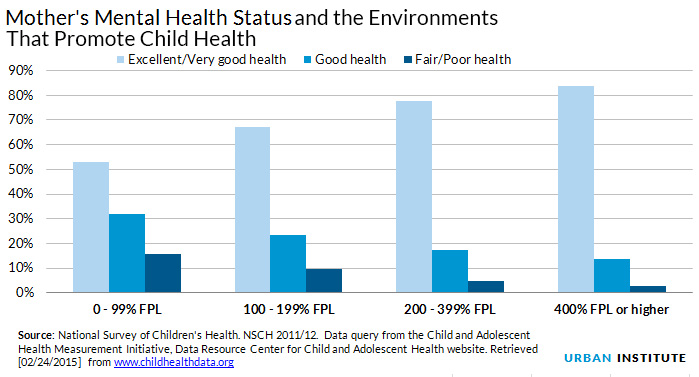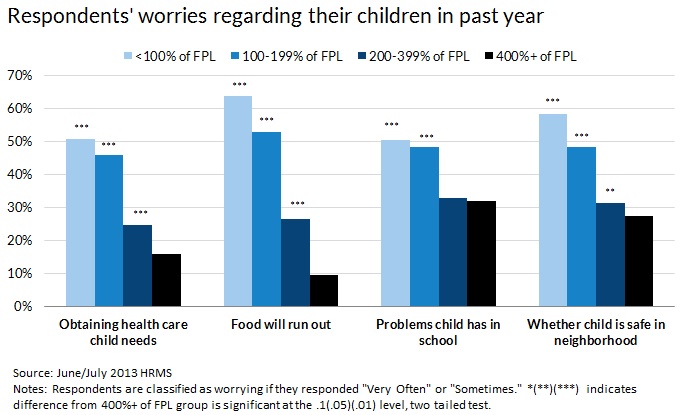
The higher your income, the better your health—and not just because higher-income families can afford better medical care. Income also affects the environments that people live in and the many factors that add up to good health. This relationship between income and health begins before conception, exists at birth and persists throughout childhood and into adulthood. So just how does income get under our skin to affect our health and survival?
The building blocks of adult health begin in infancy and childhood. Health derives from the environments in which children live, learn, and play. And children’s early experiences affect their long-term health, well-being, and success in life. Children have unique health and developmental needs that go far beyond medical care. In order to get on a path toward a healthy and successful life, children need responsive and reliable relationships with parents and other caretakers, safe and secure environments, adequate and appropriate nutrition, and to develop health-promoting behaviors and habits.
The foundation for good health is laid by families and communities, but their ability to support child health and development often depends on income. Just how different are the environments in which children from high- and low-income families are raised? Very different. Families that are better off can provide their children with better educational and recreational opportunities that foster social, physical, and intellectual growth as well as higher-quality medical services. They can also afford to live in neighborhoods with higher-quality daycare and schools, safer places for their children to play, and better access to healthy foods.
Higher incomes also protect children beyond what families can buy: for example, parents with higher incomes have lower levels of stress and depression, which reinforces their ability to be responsive parents. In a national survey, slightly more than 50 percent of poor mothers reported having mental health that was excellent or very good, while more than 80 percent of the highest-income mothers reported these ratings. And 16 percent of poor mothers reported that their mental health was poor or fair compared to only 3 percent of the mothers with incomes above 400 percent of the federal poverty level (FPL). This differential compounds difficulties facing low-income children given that maternal depression poses risks to children’s cognitive, socio-emotional, and behavioral development—especially when children are young—and is linked to health and mental health problems for children as they grow.

Other aspects of families and communities that shape lifelong health and development also vary by a child’s family income. For example, in the Urban Institute’s Health Reform Monitoring Survey, parents were asked in June 2013 how often they worry about whether they can obtain needed medical care for their children, have enough food for their families, and whether their child is having problems in school and is safe in the neighborhood. A clear income gradient emerges from the responses: more than 50 percent of poor parents worry sometimes or very often about these four issues that affect child health. But those with higher incomes worry much less. Compared to parents with incomes 400 percent of FPL and above, poor parents are between 2 and 6 times more likely to report worrying about each of these four issues that affect their child’s health. These disparities are not limited to the poor but exist across all income groups. With one exception, parents with incomes at 400 percent of the FPL or more worry less than parents of every other income group across all four measures. And parents are worrying about more than one issue. Twenty-seven percent of poor parents worried very often about 2 or more of these issues compared to 17 percent of near-poor parents (100-199 percent of FPL), 6 percent of middle-income parents (200-399 percent of FPL), and 2 percent of high-income parents (data not shown).

Healthy children enter school more ready to learn and are more likely to become healthy and productive adults. Income-related disparities in the environments in which children are born are associated with wide disparities in health and development. In his new book “Our Kids: The American Dream in Crisis,” Robert Putnam profiles the disparities in environments at opposite ends of the income spectrum and illustrates that there are many more gaps than those we profile here. Narrowing these disparities requires investments in practices and policies that bolster incomes or mitigate the health-harming effects of lower incomes. This means strengthening the capacities of families and communities to promote child health and development, as well as adding to our knowledge and understanding of how best to do this. Ongoing work at the Urban Institute focused on families and the communities in which they live is adding critical knowledge to this growing evidence base. Our work suggests that it is not just poor children that we need to worry about, but near-poor and middle-income children too.
Tune in and subscribe today.
The Urban Institute podcast, Evidence in Action, inspires changemakers to lead with evidence and act with equity. Cohosted by Urban President Sarah Rosen Wartell and Executive Vice President Kimberlyn Leary, every episode features in-depth discussions with experts and leaders on topics ranging from how to advance equity, to designing innovative solutions that achieve community impact, to what it means to practice evidence-based leadership.